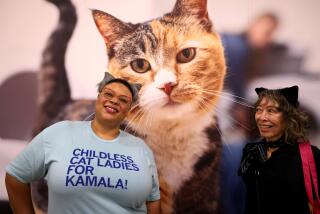It’s, Like, All About Diction--As If!
Political cartoonist Jack Ohman of the Portland Oregonian recently sketched out an alternative to impeachment for President Clinton. His cartoon depicts a tormented president covering his ears as he endures his punishment: 500 hours of community service listening to Monica Lewinsky talk about policy.
“So I go, hey, I’m like whatever about welfare reform.” Yet more evidence that people far and wide are convinced that Monica S. Lewinsky, raised in Beverly Hills and Brentwood, is a Valley Girl.
One can only imagine how Lewinsky, being from the Westside, might react: “Omigod! That is like so totally wrong! The Valley?!? As if!”
But imagine is all we can do, since the public has yet to actually hear Lewinsky’s voice. All sorts of people are curious about whether the impending impeachment hearings will reveal the true nature of Lewinsky’s diction and other verbal mannerisms. Speaking of Lewinsky in a recent interview, Mike Wallace of “60 Minutes” said that although he’s “heard all I want to hear,” he is still “curious to see if she’s a Valley Girl or not.”
Will she make that little clucking “tck” to express disdain? Will a “rilly” slip out instead of “really”? Will she go “and then I go”?
How Valley is that woman, Miss Lewinsky, anyway?
Whatever the answer, the Valley Girl’s present currency is an undeniable testament to the Valley Girl’s extraordinary endurance, resilience and ubiquity. Sixteen years after the late Frank Zappa released the Valley Girl’s namesake tune, Lewinsky’s emergence as the uber-Val of our times is, in a way, a tribute to Val power.
Valhood knows no physical boundaries, only spiritual ones. The Valley Girl has long been recognized the world over, spawning regional imitators. (What are the Spice Girls but Vals with a different accent?) At the cusp of the new millennium, the Valley Girl is still big. And now she is making weird history.
Quite a success story, of a sort, for a subspecies of humanity that first evolved in the suburbs and shopping malls of the San Fernando Valley in the late 1970s and early 1980s. When Zappa first isolated and identified this particular life form, he discerned the traits of a self-absorbed, shallow, materialistic, gabby, adolescent female who loved to shop for shoes in a place called the Galleria--a word that from her lips was practically a song in itself.
The satirical tune, sung by Zappa’s daughter, Moon Unit, became a hit and Valspeak blossomed across the land and beyond. Lyrics included such expressions as “bitchen,” “grody to the max” and “gag me with a spoon”--phrases that have fallen out of fashion for later generations of Vals. For more current verbal clues, see the film “Clueless,” its dialogue pocked by the inflected sarcasm of “as if” and “whatever.”
The Valley Girl’s language may change, but she still thrives as an icon of pop culture.
And now the Valley Girl has brought crisis to the White House.
But is Monica Lewinsky really a Val? The perception has been there from the moment her name hit the news. When Newsweek first reported on Linda Tripp’s secretly recorded audiotapes, it described the younger woman as sounding “like a neurotic, slightly spoiled Valley Girl.”
But is that really how she sounded? Instead of Valley Girl, Hollis L. Engley of the Gannett News Service mused in August, “The Monica voice might be Lauren Bacall in ‘To Have and Have Not.’ ” This is apparently wishful thinking. No less an authority than Jonah Goldberg--son of book agent Lucianne Goldberg, who first urged Tripp to tape her conversations with Lewinsky--told CNN: “It’s a Valley Girl voice. . . She sounded like a sophomore in high school, complaining [about] the captain of the football team.”
The Val image wouldn’t have stuck if Lewinsky were from, say, Long Island. Her L.A. roots are no doubt important; the worldwide media think the difference between Brentwood and Encino is just geographical hair-splittiing. As a certain president might put it, it all depends what you mean by “Val.”
Besides, although Lewinsky hailed from the Westside, her father practices medicine in the Valley and her former lawyer lives in Sherman Oaks. Other traits factored into the equation. After the scandal broke, fellow interns portrayed her as a showy, flirtatious California girl who seemed out of place among the Ivy Leaguers. We also know she liked to shop, particularly at the Gap.
Little wonder, then, that a recent Lexis-Nexis search of stories containing the terms “Monica Lewinsky” and “Valley Girl” came up with more than 100 hits. After eliminating duplications, there were still more than 75 in English-language newspapers, some as far away as Singapore.
New York Times columnist Maureen Dowd has used the term at least three times and more recently likened Lewinsky to a “Valley mall rat.” In The Independent of London, Suzanne Moore offered a mean meditation on a woman whose image precedes her: “See her as a spoilt Valley Girl who certainly expects something for nothing, because that’s what she is accustomed to.”
On CNBC’s “Upfront Tonight,” reporter Jane Wells and anchor Diane Dimond seemed to have more than an intellectual grasp of the Val phenomenon.
Wells: “Reading these transcripts today has been very odd. I mean, they even mark in here, Diane, where Monica burps and snorts and whatever.”
Dimond: “Oh, my God.”
Wells: “It--it says snorts in parentheses.”
And then Dimond: “I, you know, I’m--I’m an L.A. native. I’m a Valley Girl and this stuff is like classic Valley Girl talk. I can’t wait to hear it. It’s like when you’re in high school with your girlfriend on the phone.”
It’s all kind of funny, perhaps pathetically so, this Valley Girlish emphasis on style over substance. Has the whole world gone Val?
What Lewinsky says on the tapes isn’t news anymore.
But inquiring minds want to know how she says it.
*
Scott Harris’ column appears Tuesdays, Thursdays and Sundays. Readers may write to him at The Times’ Valley Edition, 20000 Prairie St., Chatsworth 91311, or via e-mail at scott.harris@latimes.com. Please include a phone number.
More to Read
The biggest entertainment stories
Get our big stories about Hollywood, film, television, music, arts, culture and more right in your inbox as soon as they publish.
You may occasionally receive promotional content from the Los Angeles Times.










